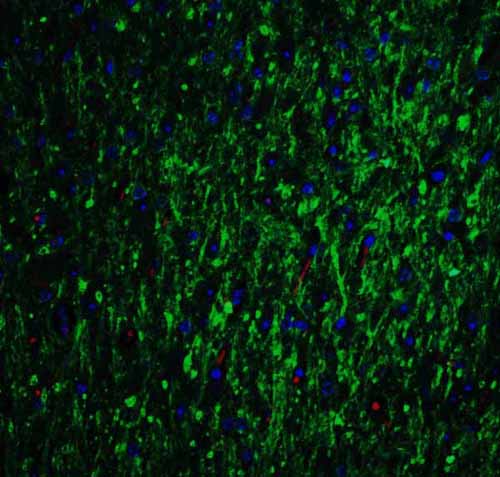GPR3 Antibody
- SPECIFICATION
- CITATIONS
- PROTOCOLS
- BACKGROUND

Application
| WB, IHC-P, IF, E |
|---|---|
| Primary Accession | P46089 |
| Other Accession | P46089, 2827 |
| Reactivity | Human, Mouse, Rat |
| Host | Rabbit |
| Clonality | Polyclonal |
| Isotype | IgG |
| Calculated MW | 35010 Da |
| Application Notes | GPR3 antibody can be used for detection of GPR3 by Western blot at 1 - 2 μg/mL. Antibody can also be used for immunohistochemistry starting at 2.5 μg/mL. For immunofluorescence start at 20 μg/mL. |
| Gene ID | 2827 |
|---|---|
| Target/Specificity | GPR3 antibody was raised against a 13 amino acid synthetic peptide from near the carboxy terminus of human GPR3. The immunogen is located within the last 50 amino acids of GPR3. |
| Reconstitution & Storage | GPR3 antibody can be stored at 4℃ for three months and -20℃, stable for up to one year. As with all antibodies care should be taken to avoid repeated freeze thaw cycles. Antibodies should not be exposed to prolonged high temperatures. |
| Precautions | GPR3 Antibody is for research use only and not for use in diagnostic or therapeutic procedures. |
| Name | GPR3 |
|---|---|
| Synonyms | ACCA |
| Function | Constitutively active G-protein coupled receptor that maintains high 3'-5'-cyclic adenosine monophosphate (cAMP) levels that a plays a role in serveral processes including meiotic arrest in oocytes or neuronal development via activation of numerous intracellular signaling pathways. Acts as an essential activator of thermogenic adipocytes and drives thermogenesis via its intrinsic G(s)- coupling activity without the requirement of a ligand (PubMed:34048700). Has a potential role in modulating a number of brain functions, including behavioral responses to stress (By similarity), amyloid-beta peptide generation in neurons (By similarity). Stimulates neurite outgrowth in cerebellar granular neurons modulated via PKA, ERK, and most strongly PI3K-mediated signaling pathways (By similarity). |
| Cellular Location | Cell membrane; Multi-pass membrane protein. |
| Tissue Location | Expressed predominantly in the central nervous system, and at low levels in the lung, kidney, testis, ovary and eye Highly expressed in regions of the brain implicated in the Alzheimer disease |

Thousands of laboratories across the world have published research that depended on the performance of antibodies from Abcepta to advance their research. Check out links to articles that cite our products in major peer-reviewed journals, organized by research category.
info@abcepta.com, and receive a free "I Love Antibodies" mug.
Provided below are standard protocols that you may find useful for product applications.
Background
GPR3 Antibody: GPR3, also known as ACCA, is a G-protein coupled receptor that constitutively activates adenylate cyclase and is highly expressed in the central nervous system. Overexpression of GPR3 stimulates the production of amyloid-beta peptide (Abeta), the deposition of which is one of the pathological hallmarks of Alzheimer 's disease (AD), while the ablation of GPR3 prevented the accumulation of Abeta in vitro and in an AD mouse model. This is of particular interest because of the proximity of a reported candidate Alzheimer 's disease (AD) locus, suggesting that GPR3 may be a potential therapeutic target for the treatment of AD. GPR3 has also been shown to block the proliferation of cerebellar granule cell precursors (GCP) during postnatal development by inhibiting the Shh-induced proliferation of GCP, indicating that GPR3 activation may represent one of the signals that triggers the postnatal cell cycle exit and terminal differentiation of GPCs.
References
Marchesse A, Docherty JM, Nguyen T, et al. Cloning of human genes encoding novel G protein-coupled receptors. Genomics1994; 23:609-18.
Eggerickx D, Denef JF, Labbe O, et al. Molecular cloning of an orphan G-protein-coupled receptor that constitutively activates adenylate cyclase. Biochem. J.1995; 309:837-43.
Thathiah A, Spittaels K, Hoffmann M, et al. The orphan G protein-coupled receptor 3 modulates amyloid-beta peptide generation in neurons. Science2009; 323:946-951.
Blacker D, Bertram L, Saunder AJ, et al. Results of a high-resolution genome screen of 437 Alzheimer’s disease families. Hum. Mol. Genet.2003; 12:23-32.
If you have used an Abcepta product and would like to share how it has performed, please click on the "Submit Review" button and provide the requested information. Our staff will examine and post your review and contact you if needed.
If you have any additional inquiries please email technical services at tech@abcepta.com.













 Foundational characteristics of cancer include proliferation, angiogenesis, migration, evasion of apoptosis, and cellular immortality. Find key markers for these cellular processes and antibodies to detect them.
Foundational characteristics of cancer include proliferation, angiogenesis, migration, evasion of apoptosis, and cellular immortality. Find key markers for these cellular processes and antibodies to detect them. The SUMOplot™ Analysis Program predicts and scores sumoylation sites in your protein. SUMOylation is a post-translational modification involved in various cellular processes, such as nuclear-cytosolic transport, transcriptional regulation, apoptosis, protein stability, response to stress, and progression through the cell cycle.
The SUMOplot™ Analysis Program predicts and scores sumoylation sites in your protein. SUMOylation is a post-translational modification involved in various cellular processes, such as nuclear-cytosolic transport, transcriptional regulation, apoptosis, protein stability, response to stress, and progression through the cell cycle. The Autophagy Receptor Motif Plotter predicts and scores autophagy receptor binding sites in your protein. Identifying proteins connected to this pathway is critical to understanding the role of autophagy in physiological as well as pathological processes such as development, differentiation, neurodegenerative diseases, stress, infection, and cancer.
The Autophagy Receptor Motif Plotter predicts and scores autophagy receptor binding sites in your protein. Identifying proteins connected to this pathway is critical to understanding the role of autophagy in physiological as well as pathological processes such as development, differentiation, neurodegenerative diseases, stress, infection, and cancer.


